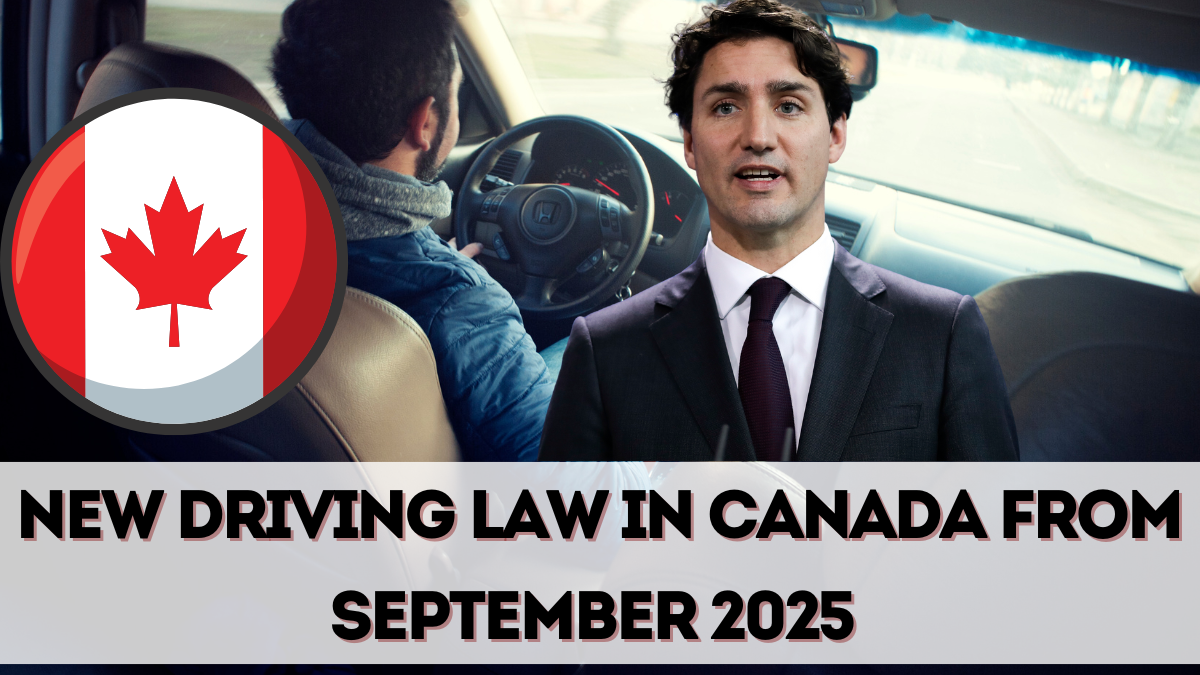Starting September 2025, Canada will enforce a new federal driving law that impacts all motorists across the country. Announced by the Ministry of Transport, this reform is part of the government’s efforts to improve road safety, reduce accidents, and modernize traffic rules. The new driving law Canada 2025 will introduce stricter penalties, updated compliance requirements, and fresh guidelines for both new and experienced drivers.

Why the New Law Was Introduced
The Canadian government implemented this reform to tackle pressing concerns in the transportation sector:
-
High Road Accidents: An increase in fatal collisions due to distracted and impaired driving.
-
Modern Challenges: Growth of electric vehicles and rise of ridesharing services required updated laws.
-
Uniform Regulations: Ensuring consistent driving standards across provinces.
-
Public Safety: Protecting pedestrians, cyclists, and vulnerable road users.
This law is considered the most comprehensive driving reform in Canada in over a decade.
Key Features of the New Driving Law
The new driving law Canada 2025 introduces multiple changes that motorists must know:
-
Stricter Distracted Driving Rules: Use of handheld devices will attract fines of up to $1,200 and license suspensions.
-
Mandatory Seatbelt Checks: Fines doubled for passengers not wearing seatbelts, including back seats.
-
New Speeding Penalties: Higher fines for exceeding limits in school and construction zones.
-
Electric Vehicle (EV) Regulations: EVs must meet new charging station compliance standards on highways.
-
Ride-Share Licensing: Uber, Lyft, and other drivers must carry updated permits with background checks.
-
Zero-Tolerance Alcohol Policy for New Drivers: Strict enforcement for motorists under 21 and probationary drivers.
Together, these measures target safer and more responsible road behavior.
Penalties and Fines Under the New Law
Penalties under the September 2025 law are tougher than before:
-
Distracted Driving: $800 to $1,200 fine plus four demerit points.
-
Seatbelt Violation: $300 fine per unbuckled passenger.
-
Speeding in Sensitive Zones: Minimum $600 fine with possible court summons.
-
Drunk Driving (New Drivers): Immediate license suspension plus mandatory rehabilitation.
-
Repeat Offenders: Double penalties and potential vehicle impoundment.
These stricter rules are designed to discourage careless driving and promote accountability.
Impact on Canadian Motorists
The law will affect motorists in several ways:
-
Safer Roads: Reduced accidents due to stricter enforcement.
-
Higher Costs for Violations: Increased fines act as a deterrent but may also impact low-income drivers.
-
More Compliance Requirements: Especially for EV owners and rideshare drivers.
-
Increased Awareness: Drivers will need to stay updated on road rules to avoid penalties.
Overall, the reform balances road safety with modern driving needs.
Steps Motorists Must Take
To comply with the new driving law Canada 2025, motorists should:
-
Ensure all passengers, including in the back seat, wear seatbelts.
-
Avoid mobile phone use unless with hands-free technology.
-
Follow posted speed limits strictly, especially near schools.
-
For EV owners, verify compliance with updated charging standards.
-
Rideshare drivers must renew permits and clear background checks.
-
Young or probationary drivers should strictly avoid alcohol before driving.
These measures ensure safe and lawful driving practices.
How Provinces Will Implement the Law
While the law is federal, provinces will be responsible for enforcement. For example:
-
Ontario: Introducing additional roadside checks for distracted driving.
-
British Columbia: More speed cameras in accident-prone areas.
-
Quebec: Mandatory seatbelt campaigns in rural areas.
-
Alberta: Increased fines for repeat offenders within 12 months.
Each province will adapt rules while maintaining the federal framework.
Benefits of the New Law
The benefits of the reform are far-reaching:
-
Lives Saved: Fewer road fatalities expected.
-
Better Compliance: Consistency across provinces ensures clarity.
-
Encourages Safe EV Transition: Establishing national EV standards.
-
Boosts Public Confidence: Citizens feel safer on roads.
These long-term improvements will strengthen Canada’s road safety culture.
Challenges and Concerns
However, the law is not without criticism:
-
Higher Fines: May disproportionately affect lower-income groups.
-
Enforcement Issues: Provinces with fewer resources may struggle.
-
EV Compliance Costs: Small EV owners may face extra expenses for upgrades.
-
Public Awareness: Some drivers may not be fully informed before September rollout.
To address this, the government is launching nationwide awareness campaigns.
Tips for Drivers to Stay Prepared
Motorists should adopt proactive habits ahead of the law’s rollout:
-
Read the official CRA and Ministry of Transport updates.
-
Enroll in defensive driving courses to reduce insurance premiums.
-
Install hands-free devices to comply with distracted driving rules.
-
Service EVs and check for new compliance needs.
-
Encourage family and friends to stay updated on changes.
Preparedness will prevent unnecessary fines and penalties.
FAQs
When does the new driving law come into effect?
It begins nationwide on September 1, 2025.
What is the highest penalty under the new rules?
Distracted driving can attract fines up to $1,200 and license suspension.
Are these laws the same across all provinces?
Yes, but provinces may introduce additional measures alongside federal rules.
Do rideshare drivers need to reapply for licenses?
Yes, rideshare drivers must update permits and clear new background checks.
How will EV owners be affected?
They must comply with federal charging and highway safety standards starting September 2025.
Click here to know more.
